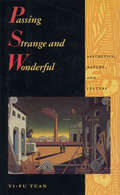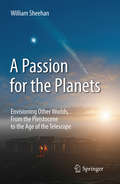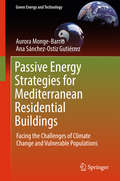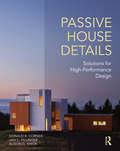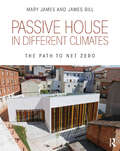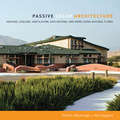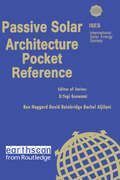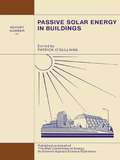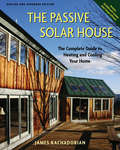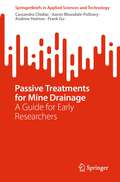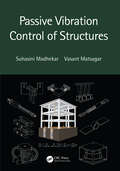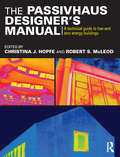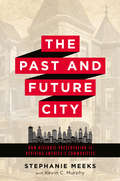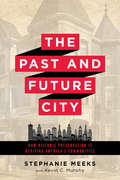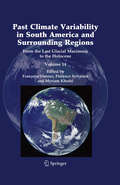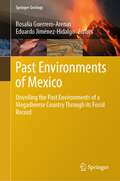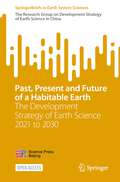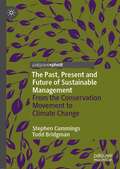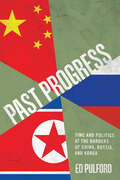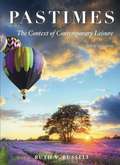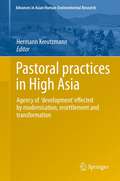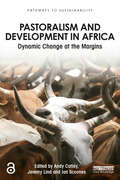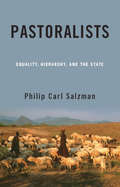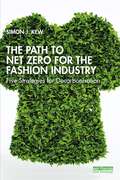- Table View
- List View
Pass the Energy, Please!
by Barbara McKinneyNature's food chains are sometimes short (grass eaten by deer) and sometimes long (goldenrod eaten by caterpillar, eaten by spider, eaten by warbler, eaten by weasel, eaten by fox). Everyone is part of nature's fascinating circle of players.
Passing Strange and Wonderful: Aesthetics Nature And Culture
by Yi-Fu TuanIn this rich and rewarding work, Yi-Fu Tuan vividly demonstrates that feeling and beauty are essential components of life and society. The aesthetic is not merely one aspect of culture but its central core -- both its driving force and its ultimate goal.Beginning with the individual and his physical world, Tuan's exploration progresses from the simple to the complex. His initial evaluation of the building blocks of aesthetic experience (sight, hearing, smell, taste, touch) develops gradually into a wide-ranging examination of the most elaborate of human constructs, including art, architecture, literature, philosophy, music, and more.
A Passion for the Planets: Envisioning Other Worlds, From the Pleistocene to the Age of the Telescope
by William SheehanAstronomy is by far the most popular of the physical sciences, enticing enough to become a major cultural preoccupation for many, and for some an enthralling scientific activity which veritably rules their lives. What is the nature of that seemingly unstoppable attraction? In this lively and compelling account, William Sheehan - professional psychiatrist, noted historian of astronomy, and incurable observer - explores the nature of that allure through the story of man's visual exploration of the planets. In this volume, the first of a trilogy, Sheehan starts with observational astronomy's profound and lasting effect on his own life, setting the points of embarkation for the journey to come. He travels across the historical landscape seeking the earliest origins of man's compulsion to observe the planets among the hunter gatherers of the upper palaeolithic, and traces the evolving story from the planetary records of the earliest cities, to Pharonic Egypt through to Hellenistic Greek astronomy culminating in Ptolemy. The necessity to observe played its part in the perceptual changes wrought by the Copernican revolution, as well as the observational advances achieved by such extraordinary characters as Tycho with his sharpest of eyes, and his luxurious practice of total astronomy. The two epochal advances published in 1609, both born through planetary observation, namely Kepler's discovery of the true nature of the orbit of Mars and Harriot and Galileo's observations of the Moon, have a pivotal place in this account. Sheehan weaves a rich tapestry of social and technological settings, patronage and personalities, equipment and skills, cosmologies and goals, motives and compulsions to try to explain why we have observed, and continue to observe, the planets. The compelling text of A Passion for the Planets is enhanced by the specially commissioned planetary artwork of Julian Baum, himself son of a noted planetary observer and historian of planetary observers, and Randall Rosenfeld. A Passion for the Planets will be of interest to all amateur astronomers; active planetary observers; armchair astronomers; those interested in the history of astronomy; the cultural history of science; and astronomical art.
Passive Energy Strategies for Mediterranean Residential Buildings
by Aurora Monge-Barrio Ana Sánchez-Ostiz GutiérrezThis book presents an approach to energy-efficient building design, which takes into account the most important challenges in climate change mitigation and adaptation in Southern Europe. It outlines a specific approach related to residential buildings and their intergenerational and vulnerable occupants, such as ageing population and users in fuel poverty. It also focuses on the use of passive energy measures throughout the year, and on pursuing a realistic and affordable approach to the efficient rehabilitation of resilient residential buildings.In addition, the book presents case studies that include surveys, monitoring, and simulation of residential buildings in Spain and other Southern European representative locations, in order to go further on the study of this challenging topic.
Passive House Details: Solutions for High-Performance Design
by Donald B. Corner Jan C. Fillinger Alison G. KwokPassive House Details introduces the concepts, principles, and design processes of building ultralow-energy buildings. The objective of this book is to provide design goals, research, analysis, systems, details, and inspiring images of some of the most energy-efficient, carbon-neutral, healthy, and satisfying buildings currently built in the region. Other topics included: heat transfer, moisture management, performance targets, and climatic zones. Illustrated with more than 375 color images, the book is a visual catalog of construction details, materials, and systems drawn from projects contributed from forty firms. Fourteen in-depth case studies demonstrate the most energy-efficient systems for foundations, walls, floors, roofs, windows, doors, and more.
Passive House in Different Climates: The Path to Net Zero
by Mary James James BillPassive House in Different Climates introduces the seven Passive House principles, to help you create super-insulated, airtight buildings that require minimal energy use to heat, cool, dehumidify, and ventilate, with superior indoor air quality and year-round comfort. Seventeen case studies in four climate zones---marine, cold and very cold, mixed-dry and hot-dry, and mixed-humid and hot-humid---and in ten countries, show you how to achieve net-zero energy regardless of where you’re building or what type of building is required. Includes more than 150 color illustrations.
Passive Solar Architecture
by David A. Bainbridge Ken HaggardThis pocket reference book provides a wealth of practical information at your fingertips, whenever you need it. Rich in background detail, at-a-glance tables and diagrams, equations, and more, the Passive Solar Architecture Pocket Referenceis a handy resource for architects, engineers and students. Coverage includes: Definitions Load determinants and Responses (including world wide biomes and climates, building metabolism and response, thermal sources and sinks, passive building responses to sources and sinks, tuning the building to the environment, optimizing insulation & thermal mass for comfort) Contextual Aspects (including microclimate and siting, temperatures, humidity, wind, radiation and comfort parameters) Passive Components (including building envelope, passive solar terminology, orientation, apertures and glazing, thermal storage, thermal control and materials Design Tools (including sun path diagrams, sun peg diagrams, air flow relationships, thermal modelling and life cycle design) Specific Functions (including passive heating, passive cooling and ventilation, natural lighting, passive water heating, resource collection and Integrated design)
Passive Solar Architecture Pocket Reference (Energy Pocket Reference)
by Ken Haggard David A. Bainbridge Rachel AljilaniOur pocket reference books provide a wealth of practical information at your fingertips, whenever you need it. Rich in background detail, at-a-glance tables and diagrams, equations, and more, the Passive Solar Architecture Pocket Reference is a handy resource for architects, engineers and students. Coverage includes: definitions load determinants and Responses (including world wide biomes and climates, building metabolism and response, thermal sources and sinks, passive building responses to sources and sinks, tuning the building to the environment, optimizing insulation & thermal mass for comfort) contextual aspects (including microclimate and siting, temperatures, humidity, wind, radiation and comfort parameters passive components (including building envelope, passive solar terminology, orientation, apertures and glazing, thermal storage, thermal control and materials design tools (including sun path diagrams, sun peg diagrams, air flow relationships, thermal modelling and life cycle design specific functions (including passive heating, passive cooling and ventilation, natural lighting, passive water heating, resource collection and integrated design).
Passive Solar Energy in Buildings: Watt Committee: report number 17
by Patrick O´SullivanThis report indicates that the benefits that accrue to a building and its occupants from a consideration of solar radiation are greatest when the 'passive solar component' is seen in perspective, as a natural part of an integrated approach to climatically interactive low-energy building design.
The Passive Solar House
by James KachadorianRevised and Expanded Edition-Includes CD-ROM with Custom Design SoftwareFor the past ten years The Passive Solar House has offered proven techniques for building homes that heat and cool themselves, using readily available materials and methods familiar to all building contractors and many do-it-yourself homeowners. True to this innovative, straightforward approach, the new edition of this best-selling guide includes CSOL passive solar design software, making it easier than ever to heat your home with the power of the sun. Since The Passive Solar House was first published, passive solar construction expert James Kachadorian has perfected user-friendly, Windows-compatible software to supplement the design process explained in the book by allowing homeowners/designers to enter the specifications of their design and see how changing a variable will affect its energy efficiency. This is the building book for a world of climbing energy costs. Applicable to diverse regions, climates, budgets, and styles of architecture, Kachadorian's techniques translate the essentials of timeless solar design into practical wisdom for today's solar builders. Profiles of successful passive solar design, construction, and retrofit projects from readers of the first edition provide inspiration to first-time homebuilders and renovators alike.
Passive Treatments for Mine Drainage: A Guide for Early Researchers (SpringerBriefs in Applied Sciences and Technology)
by Cassandra Chidiac Aaron Bleasdale-Pollowy Andrew Holmes Frank GuThis book allows readers to grasp both the fundamentals and the latest technological advances in the field of mine drainage, which is increasingly crucial both environmentally and economically. Its extensive coverage of current and promising passive treatment technologies, combined with numerous practical guides, makes it an indispensable tool for early researchers seeking promising trends and identifying gaps.The book systematically explores recent literature on passive treatment research, classifying them as preventative, in-situ, and ex-situ solutions. It covers relevant passive treatments such as permeable reactive barriers, constructed wetlands, gravel bed reactors, saturated rock fills, and passivation techniques, among other common source control tactics. Each technology is discussed in terms of principal mechanisms, state-of-the-art technological advances, advantages and disadvantages, and suitability for a given mine drainage chemistry and flow regime. The book provides a comprehensive view of the entire field, offering researchers and policymakers a reference guide, research ideas, understanding, and practical applications for each technology.Furthermore, the contains an overview of recent trends in material selection for passive treatment applications, primarily through the use of industrial waste and by-products, which incorporate more sustainable practices in mine drainage remediation. Uniquely, the manuscript includes a flowchart based on water chemistry and flow rates to guide readers to ideal treatment options, along with written analysis to further support the readers’ decision-making. Overall, this equips early researchers in the field with knowledge of fundamentals and promising research routes when dealing with different mine drainage complexities while also providing them with promising research avenues that can advance the field further.
Passive Vibration Control of Structures
by Suhasini Madhekar Vasant MatsagarResearch in vibration response control deals not only with prevention of catastrophic failures of structures during natural or accidental/manmade hazards but also ensures the comfort of occupants through serviceability. Therefore, the focus of this book is on the theory of dynamic response control of structures by using different kinds of passive vibration control devices. The strategies used for controlling displacement, velocity, and acceleration response of structures such as buildings, bridges, and liquid storage tanks under the action of dynamic loads emanating from earthquake, wind, wave, and so forth are detailed. The book: Explains fundamentals of vibration response control devices and their practical applications in response mitigation of structures exposed to earthquake, wind, and wave loading Offers a comprehensive overview of each passive damper, its functioning, and mathematical modeling in a dynamical system Covers practical aspects of employing the passive control devices to some of the benchmark problems that are developed from existing buildings and bridges in different countries worldwide Includes MATLAB® codes for determining the dynamic response of single degree of freedom (SDOF) and multi-degree of freedom (MDOF) systems along with computational models of the passive control devices This book is aimed at senior undergraduate students, graduate students, and researchers in civil, earthquake, aerospace, automotive, mechanical engineering, engineering dynamics, and vibration control, including structural engineers, architects, designers, manufacturers, and other professionals.
The Passivhaus Designer’s Manual: A technical guide to low and zero energy buildings
by Christina J. Hopfe Robert S. McLeodPassivhaus is the fastest growing energy performance standard in the world, with almost 50,000 buildings realised to date. Applicable to both domestic and non-domestic building types, the strength of Passivhaus lies in the simplicity of the concept. As European and global energy directives move ever closer towards Zero (fossil) Energy standards, Passivhaus provides a robust ‘fabric first’ approach from which to make the next step. The Passivhaus Designers Manual is the most comprehensive technical guide available to those wishing to design and build Passivhaus and Zero Energy Buildings. As a technical reference for architects, engineers and construction professionals The Passivhaus Designers Manual provides: State of the art guidance for anyone designing or working on a Passivhaus project; In depth information on building services, including high performance ventilation systems and ultra-low energy heating and cooling systems; Holistic design guidance encompassing: daylight design, ecological materials, thermal comfort, indoor air quality and economics; Practical advice on procurement methods, project management and quality assurance; Renewable energy systems suitable for Passivhaus and Zero Energy Buildings; Practical case studies from the UK, USA, and Germany amongst others; Detailed worked examples to show you how it’s done and what to look out for; Expert advice from 20 world renowned Passivhaus designers, architects, building physicists and engineers. Lavishly illustrated with nearly 200 full colour illustrations, and presented by two highly experienced specialists, this is your one-stop shop for comprehensive practical information on Passivhaus and Zero Energy buildings.
The Past and Future City: How Historic Preservation is Reviving America's Communities
by Ms Stephanie Meeks Mr Kevin C. MurphyInThe Past and Future City,Stephanie Meeks, the president of the National Trust for Historic Preservation, describes in detail, and with unique empirical research, the many ways that saving and restoring historic fabric can help a city create thriving neighborhoods, good jobs, and a vibrant economy. She explains the critical importance of preservation for all our communities, the ways the field of historic preservation has evolved to embrace the challenges of the twenty-first century, and the innovative work being done in the preservation space now.This book is for anyone who cares about cities, places, and saving America's diverse stories in a way that will bring us together and help us better understand our past, present, and future.
The Past and Future City: How Historic Preservation is Reviving America's Communities
by Ms Stephanie Meeks Mr Kevin C. MurphyInThe Past and Future City,Stephanie Meeks, the presidof the National Trust for Historic Preservation, describes in detail, and with unique empirical research, the many ways that saving and restoring historic fabric can help a city create thriving neighborhoods, good jobs, and a vibrant economy. She explains the critical importance of preservation for all our communities, the ways the field of historic preservation has evolved to embrace the challenges of the twenty-first century, and the innovative work being done in the preservation space now.This book is for anyone who cares about cities, places, and saving America's diverse stories in a way that will bring us together and help us better understand our past, present, and future.
Past Climate Variability in South America and Surrounding Regions
by Florence Sylvestre Francoise Vimeux Myriam KhodriThis book groups together overviews and original research papers dealing with South American climate variability from the Last Glacial Maximum to the Holocene. The contributions deal with tropical, temperate and high latitudes climate variability in South America and in surrounding regions (including Pacific and Atlantic Oceans and Antarctica). It offers results obtained from both natural climate archives and recent simulations from coupled climate models. The objective is to propose a state of the art about our knowledge of past climate variability in South America. Specifically, this book aims at presenting the whole available observations and at discussing climate mechanisms, specifically the low to high latitude teleconnections on that continent which spreads out from the equator to Patagonia. It is written by an expert group of climate change scientists, and presents an insight into dynamics of the past and provides climate modellers with work of reference for data-model comparison. The book is an advanced but very readable text essential for all students and scientists interested in global environmental change.
Past Environments of Mexico: Unveiling the Past Environments of a Megadiverse Country Through its Fossil Record (Springer Geology)
by Rosalía Guerrero-Arenas Eduardo Jiménez-HidalgoMexico is a biodiverse country. The dynamics of environments from Mexico played a crucial role in the history of North American biota. This book analyzes the paleoenvironmental conditions using several biological groups and various methods. This book also demonstrates how this information is specifically used to elucidate Mexico‘s past environments and habitats (terrestrial, freshwater, and marine). This book fills an existing editorial gap since much of the information is dispersed in several bibliographic sources. The authors are active paleontologists in diverse Mexican universities and research centers. Their research activities contribute to the knowledge of the Mexican biota through geologic time.
Past, Present and Future of a Habitable Earth: The Development Strategy of Earth Science 2021 to 2030 (SpringerBriefs in Earth System Sciences)
by Res. Group Dev Strategy of Earth ScienceThis perspective of this book views Earth's various layers as a whole system, and tries to understand how to achieve harmony and sustainable development between human society and nature, with the theme of " habitability of the Earth." This book is one effort at providing an overview of some of the recent exciting advances Chinese geoscientists have made. It is the concerted team effort of a group of researchers from diverse backgrounds to generalize their vision for Earth science in the next 10 years. The book is intended for scholars, administrators of the Science and Technology policy department, and science research funding agencies. This is an open access book.
The Past, Present and Future of Sustainable Management: From the Conservation Movement to Climate Change
by Stephen Cummings Todd BridgmanWe might think sustainable management is a new idea, created in the 1960s by enlightened modern scientists. We might think that it puts us on a new path, beyond what management was originally about. But this is not true. Sustainable management is as old as civilization and was a foundation stone of management science as it was formed in the first decade of the 20th century. Recovering this forgotten past provides deeper roots and greater traction to advance sustainable management in our own times.This book charts a history of sustainable management from premodern times, through the birth of management science as an offshoot of the conservation movement, to the present day. The authors argue that modern tools like Triple Bottom Line reporting and multiple Sustainable Development Goals may be less useful than a return to a more fundamental and holistic view of management.
Past Progress: Time and Politics at the Borders of China, Russia, and Korea
by Ed PulfordWhile anxiety abounds in the old Cold War West that progress – whether political or economic – has been reversed, for citizens of former-socialist countries, murky temporal trajectories are nothing new. Grounded in the multiethnic frontier town of Hunchun at the triple border of China, Russia, and North Korea, Ed Pulford traces how several of global history's most ambitiously totalizing progressive endeavors have ended in cataclysmic collapse here. From the Japanese empire which banished Qing, Tsarist, and Choson dynastic histories from the region, through Chinese, Soviet, and Korean socialisms, these borderlands have seen projections and disintegrations of forward-oriented ideas accumulate on a grand scale. Taking an archaeological approach to notions of historical progress, the book's three parts follow an innovative structure moving backwards through linear time. Part I explores "post-historical" Hunchun's diverse sociopolitics since high socialism's demise. Part II covers the socialist era, discussing cross-border temporal synchrony between China, Russia, and North Korea. Finally, Part III treats the period preceding socialist revolutions, revealing how the collapse of Qing, Tsarist, and Choson dynasties marked a compound "end of history" which opened the area to projections of modernity and progress. Examining a borderland across linguistic, cultural, and historical lenses, Past Progress is a simultaneously local and transregional analysis of time, borders, and the state before, during, and since socialism.
Pastimes: The Context of Contemporary Leisure (Fifth Edition)
by Ruth V. RussellOriginally published in 1996, "Pastimes" introduced an exciting new text that explored leisure and recreation philosophy and science, the various subfields, and the leisure services industry. The purpose of this fifth edition of Pastimes is to extend the discussion about leisure in society to new concepts supported by new research findings and commentary. Throughout, the author has pursued the most interesting, relevant, exciting, and contemporary information possible. First, as an introduction to the phenomenon of leisure, the book must be current. Momentous changes, actual and alleged, have always been the root of leisure expressions and experiences. To match, Pastimes again reflects a wide range of material from the disciplines of leisure studies, sociology, psychology, economics, political science, anthropology, geography, the humanities, and media and cultural studies. Second, as a learning tool, this fifth edition teaches more. It contains new illustrations of concepts through field-based cases, biographical features, exploratory activities, and research studies. While the basic organisation remains similar, in addition to new material, some former concepts have been relocated. For example, the topic of history and its meanings for leisure is now combined into one chapter. Also, the discussion of work is now combined with that about economics in the same chapter. Also, theories explaining leisure behaviour are now organised according to their home discipline. A chapter on well-being and leisure is a new feature, and because of the amazing speed of change, the chapter on leisure and technology has been completely rewritten. The chapter on time has also been expanded. Finally, the last chapter on leisure systems has a new section on professional preparation. But, more than a textbook, Pastimes is very much a point of view. Leisure is presented as a human phenomenon that is individual and collective, vital and frivolous, historical and contemporary, factual and subjective, good and bad.
Pastoral practices in High Asia
by Hermann KreutzmannIn conventional views, pastoralism was classified as a stage of civilization that needed to be abolished and transcended in order to reach a higher level of development. In this context, global approaches to modernize a rural society have been ubiquitous phenomena independent of ideological contexts. The 20th century experienced a variety of concepts to settle mobile groups and to transfer their lifestyles to modern perceptions. Permanent settlements are the vivid expression of an ideology-driven approach. Modernization theory captured all walks of life and tried to optimize breeding techniques, pasture utilization, transport and processing concepts. New insights into other aspects of pastoralism such as its role as an adaptive strategy to use marginal resources in remote locations with difficult access could only be understood as a critique of capitalist and communist concepts of modernization. In recent years a renaissance of modernization theory-led development activities can be observed. Higher inputs from external funding, fencing of pastures and settlement of pastoralists in new townships are the vivid expression of 'modern' pastoralism in urban contexts. The new modernization programme incorporates resettlement and transformation of lifestyles as to be justified by environmental pressure in order to reduce degradation in the age of climate change.
Pastoralism and Development in Africa: Dynamic Change at the Margins (Pathways to Sustainability)
by Author UnknownOnce again, the Horn of Africa has been in the headlines. And once again the news has been bad: drought, famine, conflict, hunger, suffering and death. The finger of blame has been pointed in numerous directions: to the changing climate, to environmental degradation, to overpopulation, to geopolitics and conflict, to aid agency failures, and more. But it is not all disaster and catastrophe. Many successful development efforts at ‘the margins’ often remain hidden, informal, sometimes illegal; and rarely in line with standard development prescriptions. If we shift our gaze from the capital cities to the regional centres and their hinterlands, then a very different perspective emerges. These are the places where pastoralists live. They have for centuries struggled with drought, conflict and famine. They are resourceful, entrepreneurial and innovative peoples. Yet they have been ignored and marginalised by the states that control their territory and the development agencies who are supposed to help them. This book argues that, while we should not ignore the profound difficulties of creating secure livelihoods in the Greater Horn of Africa, there is much to be learned from development successes, large and small. This book will be of great interest to students and scholars with an interest in development studies and human geography, with a particular emphasis on Africa. It will also appeal to development policy-makers and practitioners.
Pastoralists: Equality, Hierarchy, and the State
by Philip Carl SalzmanDrawing upon the author's extensive field research among pastoral peoples in the Middle East, India, and the Mediterranean, and on more than 30 years of comparative study of pastoralists around the world, Pastoralists is an authoritative synthesis of the varieties of pastoral life. At an ethnographic level, the concise volume provides detailed analyses of divergent types of pastoral societies, including segmentary tribes, tribal chiefdoms, and peasant pastoralists. At the same time, it addresses a set of substantive theoretical issues: ecological and cultural variation, equality and inequality, hierarchy and the basis of power, and state power and resistance. The book validates "pastoralists" as a conceptual category even as it reveals the diversity of societies, subsistence strategies, and power arrangements subsumed by that term.
The Path to Net Zero for the Fashion Industry: Five Strategies for Decarbonisation
by Simon J. KewThis book uses a quantitative science-based approach to explain where the greenhouse gas (GHG) emissions emitted by the fashion industry are generated and it explores what strategies can be deployed to achieve Net Zero by 2050. With GHG emissions currently predicted to triple by the middle of the century, the fashion industry is far off course to reach Net Zero, as set out in the Paris Agreement. With misinformation and greenwashing representing an ever-growing barrier to potential solutions, the book aims to demystify the source of GHG emissions from the industry, breaking down in detail their origin, while identifying the steps that can be taken when designing and sourcing new products. Detailing the market drivers and trends in fashion consumption, it argues that change should be guided by science-based quantitative principles. Accessibly written with key insights at the end of each chapter, this book will enable the reader to understand the tactics to tackle decarbonisation, and ultimately outline five main strategies that can be deployed by the fashion and textile industries to align with the Paris Agreement. This book serves as a practical guide for designers, buyers and the fashion industry in general to develop and understand approaches and strategies to reduce energy consumption and the resulting GHG emissions to reach Net Zero.

